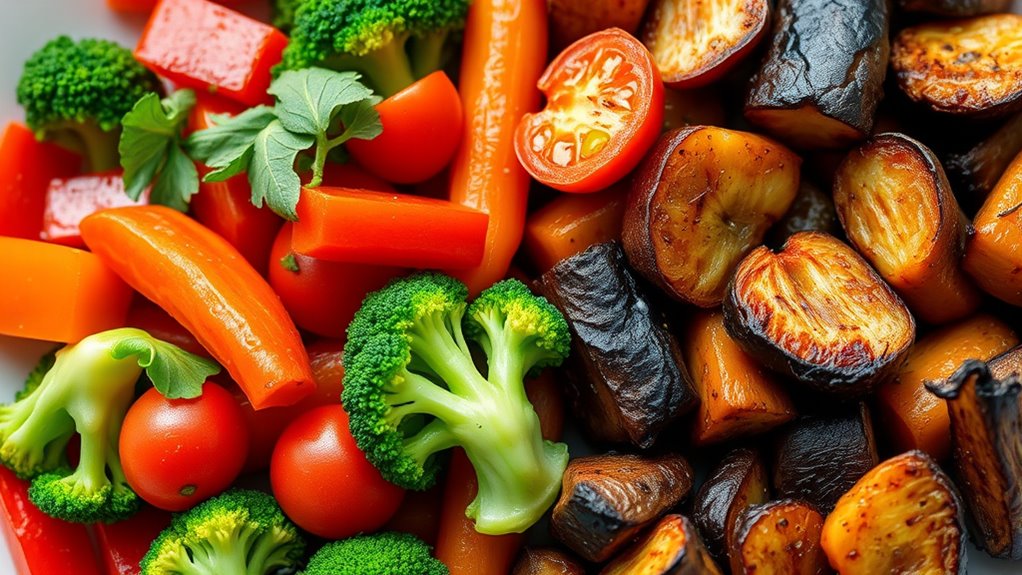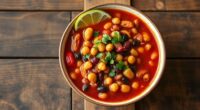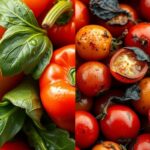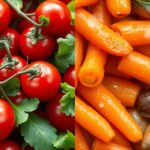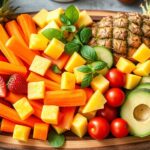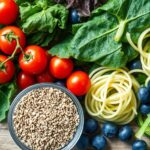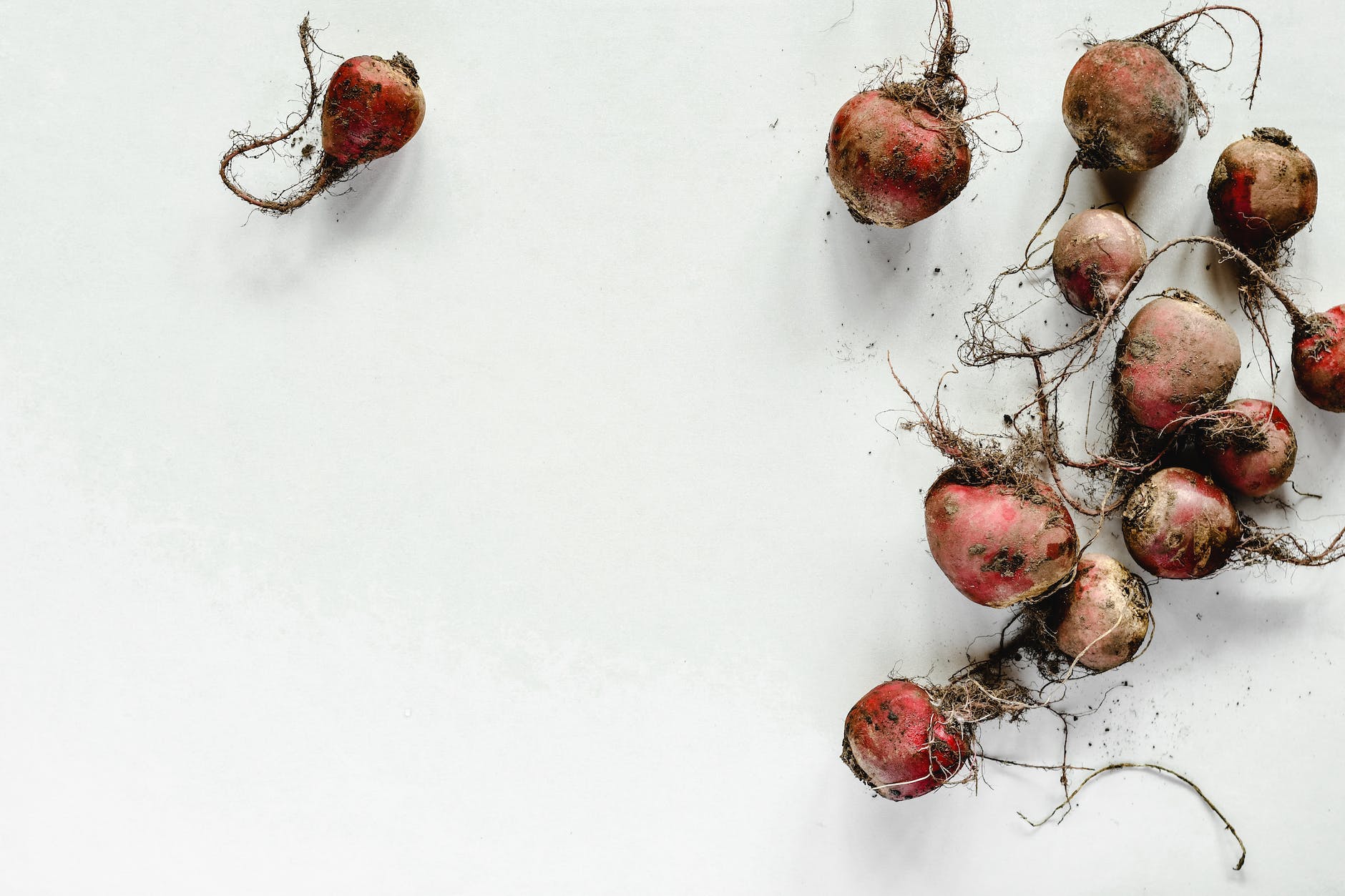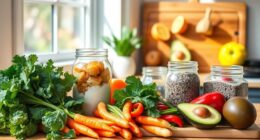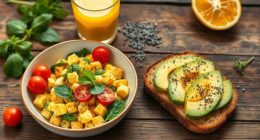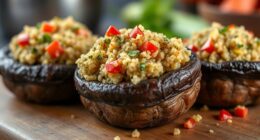Eating raw foods helps you retain antioxidants and natural enzymes that support digestion and nutrient absorption, especially for heat-sensitive nutrients like vitamin C. On the other hand, cooking can boost the bioavailability of certain nutrients, such as lycopene in tomatoes or beta-carotene in vegetables. Both methods offer unique benefits, and combining raw and cooked foods allows you to maximize nutrient intake while ensuring food safety. Continue exploring to discover how to balance both for peak health.
Key Takeaways
- Raw foods retain heat-sensitive antioxidants like vitamin C and enzymes that aid digestion.
- Cooking enhances nutrient bioavailability, making compounds like lycopene and beta-carotene more accessible.
- Heat can degrade some antioxidants, reducing their levels in cooked foods.
- Cooking eliminates harmful bacteria and parasites, improving food safety.
- Combining raw and cooked foods provides a balanced intake of nutrients and health benefits.
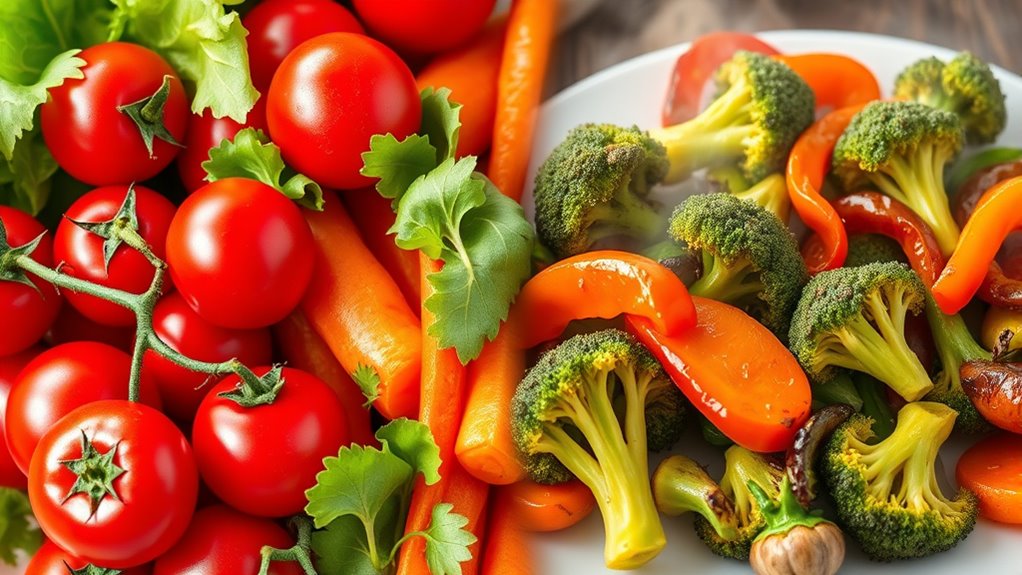
When it comes to choosing between raw and cooked foods, understanding their nutritional differences can help you make healthier decisions. One key aspect to consider is antioxidant retention. Raw foods often contain higher levels of certain antioxidants because heat can degrade these compounds. For example, berries and leafy greens tend to lose some of their antioxidant power when cooked, meaning you might get more protective benefits by consuming them raw. This is especially relevant if you’re aiming to maximize your intake of vitamins like vitamin C, which is sensitive to heat and easily destroyed during cooking. By eating some fruits and vegetables raw, you preserve these antioxidants, potentially reducing oxidative stress and supporting your immune system.
Eating raw fruits and vegetables preserves antioxidants and vitamin C, maximizing their protective health benefits.
Another important factor is enzyme preservation. Raw foods naturally contain enzymes that aid digestion and nutrient absorption. When you eat foods uncooked, you retain these natural enzymes, which can help your body break down food more efficiently. Cooking, on the other hand, often destroys these enzymes due to high temperatures. While your body produces its own digestive enzymes, consuming raw foods can give your system an extra boost, potentially easing digestion and reducing bloating. This is especially true for fruits and vegetables, where enzymes like amylase and bromelain remain active when raw. If you’re sensitive to digestion issues or want to optimize nutrient absorption, incorporating more raw foods into your diet might be beneficial.
However, it’s crucial to recognize that cooking can also enhance nutritional value by making some nutrients more bioavailable. For example, cooking tomatoes increases the availability of lycopene, a powerful antioxidant linked to heart health. Similarly, steaming or lightly cooking vegetables like carrots and spinach can break down cell walls, making vitamins like beta-carotene and lutein easier for your body to absorb. So, while raw foods excel at preserving antioxidants and enzymes, cooking can unlock other vital nutrients and improve digestibility.
Additionally, being aware of food safety considerations when consuming raw foods is important, as some raw produce may harbor bacteria or parasites that cooking can eliminate. Balancing raw and cooked foods in your diet allows you to enjoy the benefits of both. Eating a variety of raw vegetables and fruits ensures maximum antioxidant retention and enzyme preservation, supporting your overall health. Meanwhile, including cooked vegetables helps you access nutrients that become more bioavailable through heat. By understanding these differences, you can tailor your meals to optimize nutrient intake, boost your energy, and promote long-term well-being. Ultimately, the choice between raw and cooked foods isn’t about one being better but about integrating both strategies to meet your nutritional needs.
Frequently Asked Questions
How Does Cooking Affect Vitamin C Levels in Foods?
Cooking causes Vitamin C degradation in foods, reducing its levels considerably. Different cooking methods impact this loss; boiling and steaming tend to preserve more Vitamin C than frying or roasting, which can accelerate nutrient damage. When you cook, aim for gentle methods and shorter times to retain more Vitamin C. So, if you want maximum benefits, eating raw or minimally cooked foods helps preserve this essential nutrient.
Are There Specific Foods Better Consumed Raw for Nutrient Retention?
Think of raw foods as untouched gems, holding their vibrant colors and crisp textures. You’ll find that leafy greens, bell peppers, and berries preserve their full nutrient spectrum when eaten raw, offering maximum vitamin C and antioxidants. Their natural texture delights your palate, and their fresh flavor shines brightest. For these foods, raw consumption keeps nutrients intact, enhancing both the food’s lively texture and pure flavor, making each bite a nutritious celebration.
Can Cooking Reduce Harmful Bacteria Without Losing Nutrients?
Cooking can effectively reduce harmful bacteria, improving food safety without necessarily losing nutrients if done properly. Steaming, boiling, or pressure cooking preserves more nutrients than high-heat methods like frying. You should aim for gentle cooking methods and avoid overcooking to maintain nutrient preservation while ensuring food safety. This balance helps you enjoy safe, nutritious meals without sacrificing essential vitamins and minerals.
Does Raw Food Consumption Increase the Risk of Foodborne Illnesses?
Did you know that raw foods can carry up to 10 times more pathogens than cooked ones? Yes, consuming raw food increases your risk of foodborne illnesses because it challenges food safety and pathogen control. Without proper handling, bacteria like Salmonella or E. coli can thrive. To stay safe, wash produce thoroughly and avoid raw meats, especially if your immune system is compromised. Staying vigilant helps you enjoy healthy, safe meals.
How Does Cooking Influence Mineral Bioavailability in Vegetables?
Cooking methods can enhance mineral absorption in vegetables by breaking down cell walls, making nutrients more accessible. For example, steaming or boiling boosts the bioavailability of minerals like iron and calcium, whereas overcooking may cause mineral loss. You should choose cooking methods that preserve nutrients, such as steaming or sautéing, to maximize mineral absorption and enjoy the full nutritional benefits of your vegetables.
Conclusion
Just as Pandora’s box revealed both hope and chaos, choosing raw or cooked foods unleashes a balance of benefits and drawbacks. Embrace the wisdom of understanding how each method preserves nutrients or enhances flavor. By doing so, you become the master of your health, crafting meals that nourish your body and satisfy your senses. Remember, like a skilled alchemist, you hold the power to turn simple ingredients into a source of vitality and joy.
Ilana has been a vegan for over 10 years. She originally made the switch for health reasons, but soon found herself becoming more and more passionate about the ethical and environmental implications of a vegan lifestyle. Ilana is the author of The Graceful Kitchen, a blog all about veganism. She loves to cook up delicious and nutritious vegan meals, and share her recipes with others who are interested in leading a cruelty-free life. Ilana is also a strong advocate for using whole foods as the foundation of a healthy diet, and believes that going vegan is one of the best ways to achieve this.
